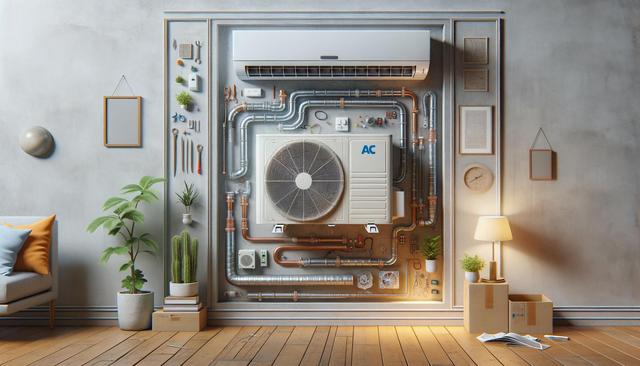Understanding How Ductless AC Works
Ductless air conditioning systems, often referred to as mini-split systems, operate differently from traditional central AC units. Instead of using extensive ductwork to distribute air, a ductless system consists of an outdoor compressor unit and one or more indoor air-handling units. These components are connected by a small conduit that houses the power cable, refrigerant tubing, suction tubing, and a condensate drain. This setup allows for direct delivery of cooled air to specific zones within a home or building.
One of the main advantages of this configuration is that it reduces energy loss, which is common in ducted systems. According to experts, duct losses can account for more than 30% of energy consumption, especially if the ducts are in unconditioned spaces like attics. Ductless systems eliminate this concern entirely. For homeowners looking into how ductless AC works, it’s also worth noting that these systems offer both cooling and heating capabilities, making them a versatile solution for year-round comfort.
Additionally, ductless systems are known for their ease of installation compared to traditional HVAC systems. Because they don’t require ductwork, they’re ideal for retrofitting older homes, cooling additions or outbuildings, or supplementing existing systems in under-served areas of the home.
Energy-Efficient Climate Control
One of the biggest appeals of ductless systems is their energy efficiency. Energy-efficient ductless systems often include features like inverter-driven compressors, which adjust speed based on the cooling demand rather than turning off and on completely. This results in more consistent temperatures and reduced energy consumption. Because of these advantages, ductless systems are frequently recognized by energy rating agencies and may even qualify for rebates or incentives in certain regions.
Homeowners can also take advantage of zone-based climate control, which allows separate temperature settings for different rooms or areas. This not only enhances comfort but also reduces unnecessary energy usage. Consider these typical benefits of energy-efficient ductless systems:
- Lower monthly energy bills
- Reduced carbon footprint
- Quieter operation
- Longer equipment lifespan due to less strain on components
If you’re comparing cooling options, it’s worth researching the best ductless AC brands known for their innovation in energy-saving technologies. These brands often offer models with high SEER (Seasonal Energy Efficiency Ratio) ratings and smart home compatibility, providing further efficiency and convenience.
Evaluating the Cost of Ductless AC Installation
When considering a switch to ductless air conditioning, understanding the cost of ductless AC installation is a key factor. While installation costs can vary depending on the size of the system and the number of zones, the absence of ductwork often makes the process faster and less labor-intensive. On average, a single-zone system is generally more affordable, while multi-zone systems can increase the price due to additional indoor units and more complex setup.
Upfront costs aside, many homeowners find that the long-term savings in energy expenses and potential maintenance costs help offset the initial investment. Additionally, the minimal disruption during installation is a major benefit for those upgrading existing homes. Factors influencing installation costs include:
- Number of indoor units required
- Complexity of placement and routing of conduit
- Local labor rates and licensing requirements
- Choice among top-rated ductless AC brands
Working with a certified HVAC professional can ensure the system is properly sized for your space and efficiently installed. It’s also a good idea to request multiple quotes to compare services and warranties.
Maintaining Your Ductless AC System
To keep your ductless system running smoothly, regular maintenance is essential. Fortunately, ductless AC maintenance tips are relatively straightforward and can often be handled by homeowners themselves with occasional professional check-ups. Routine tasks include cleaning or replacing air filters every month or two, especially during periods of heavy use. This helps maintain airflow and indoor air quality.
Other helpful ductless AC maintenance tips include:
- Wiping down the indoor unit’s exterior to prevent dust buildup
- Checking the outdoor unit for obstructions like leaves or debris
- Ensuring the condensate drain is clear to avoid water damage
- Scheduling annual professional inspections to check refrigerant levels and system operation
Preventive maintenance not only improves performance but also extends the lifespan of the system. A well-maintained ductless AC is less likely to experience operational issues and can deliver consistent comfort for years to come.
Troubleshooting Ductless AC Issues
Despite their reliability, ductless systems may occasionally face performance problems. Fortunately, many common issues have simple solutions. Understanding basic troubleshooting ductless AC issues can help homeowners address minor concerns before they escalate. For example, if the system isn’t cooling as expected, check that the filters are clean and the remote settings are correct. Also, ensure that the indoor and outdoor units have power and that no error codes are displayed.
Other common issues include:
- Unusual noises, which may indicate a loose panel or debris
- Water leakage, often caused by a clogged drain line
- Remote control malfunctions, which might require battery replacement or reprogramming
- Inconsistent temperatures, possibly due to incorrect placement of indoor units
If these steps don’t resolve the issue, it’s advisable to contact a qualified technician familiar with the best ductless AC brands and their specific diagnostic procedures. Timely repairs can prevent further damage and restore optimal performance without the need for replacement.
Conclusion: Is a Ductless AC Upgrade Right for You?
For homeowners seeking a flexible, energy-efficient, and low-maintenance cooling solution, ductless AC systems present a compelling option. Whether you’re retrofitting an older home, adding climate control to a new addition, or simply looking to upgrade your current system, ductless offers a modern alternative that avoids the complexity and cost of ductwork. By understanding how ductless AC works, being aware of the cost of ductless AC installation, following smart ductless AC maintenance tips, and staying prepared to troubleshoot ductless AC issues, you can make an informed choice that suits both your comfort and budget needs. Exploring the market’s top-rated and energy-efficient ductless systems can further enhance the value of your investment.




Leave a Reply